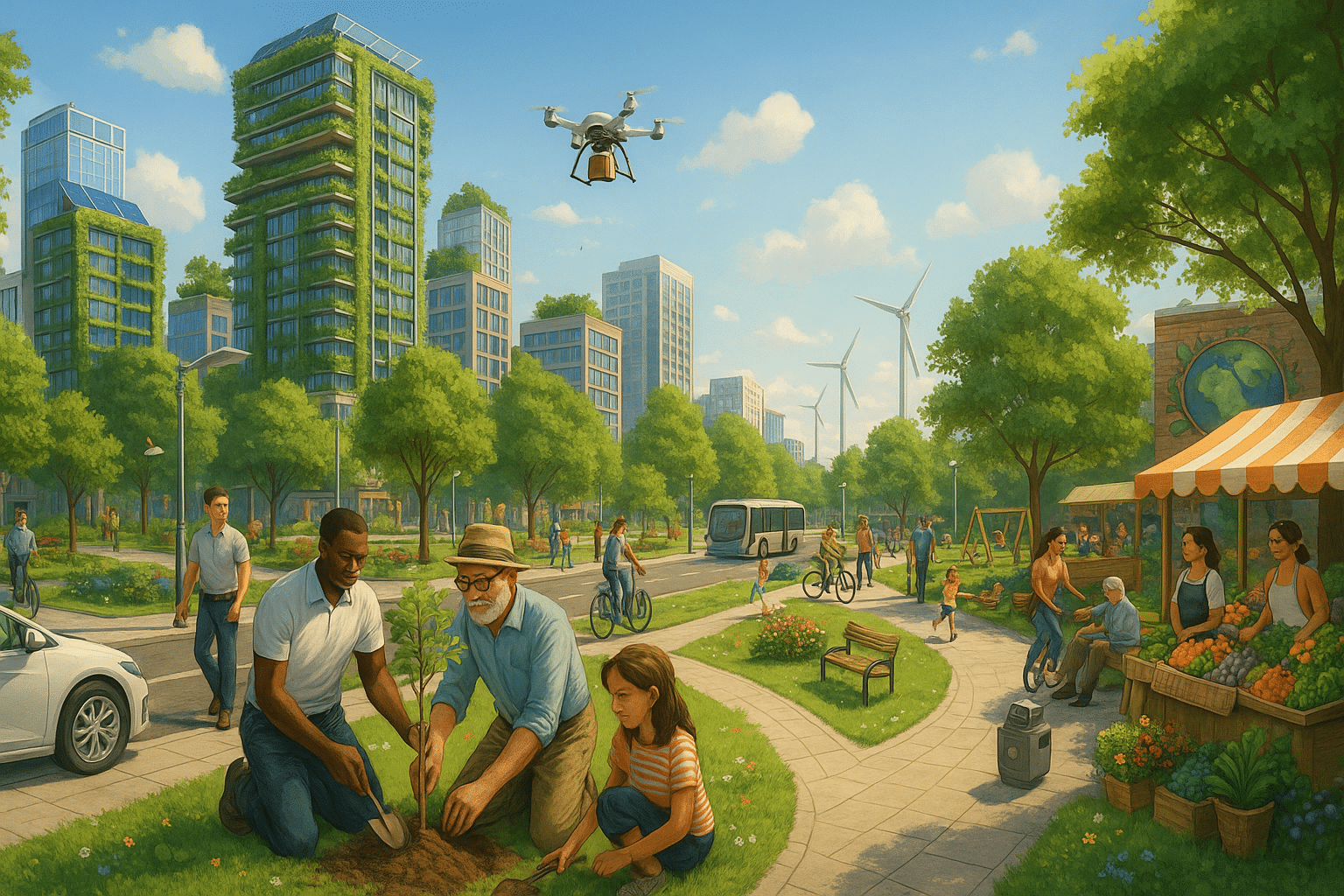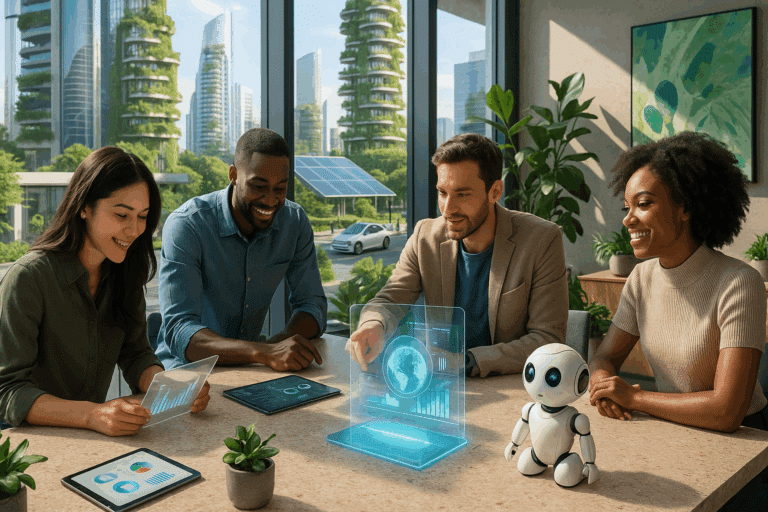🌍 An exciting prospect, isn’t it? This is the promising reality being shaped by the convergence of Sustainable Development Goals (SDGs) and Corporate Social Responsibility (CSR). Today, we delve into an enlightening exploration of how these two powerful concepts are driving positive change and shaping a better future.
But before we dive in, let’s briefly define our terms. SDGs are a set of 17 global goals set by the United Nations, which provide a blueprint for achieving a better and more sustainable future. On the other hand, CSR refers to a business model that helps companies be socially accountable—to themselves, their stakeholders, and the public—by incorporating social and environmental concerns into their business operations and interactions with their stakeholders. 😊
A Deeper Look into SDGs and CSR
We are currently living in a world filled with challenges—from poverty and inequality to climate change and environmental degradation. The good news? We also live in a world filled with potential solutions. 🌟 Among these, SDGs and CSR stand out as robust frameworks for addressing these issues and driving positive change.
SDGs provide a comprehensive roadmap for addressing global challenges, while CSR offers a way for businesses to contribute towards these goals in a way that also creates value for their stakeholders. When combined, SDGs and CSR provide a powerful approach to sustainable development—one that can lead to the creation of a more equitable, sustainable, and resilient world.
How Are SDGs and CSR Driving Positive Change?
SDGs and CSR are not just theoretical concepts—they are being actively implemented by businesses, governments, and civil society organizations worldwide. And the impact is real and tangible. 💪 From reducing poverty and improving education to promoting gender equality and mitigating climate change, these initiatives are making a significant difference.
Moreover, SDGs and CSR are also transforming the way businesses operate. No longer is profit the sole focus. Instead, businesses are now recognizing the value of creating social and environmental value as well. 🏢 This shift in mindset is not just good for society and the environment—it’s also good for business. Companies that embrace CSR and align their operations with SDGs often find that they enjoy improved reputation, enhanced customer loyalty, and increased profitability.
What’s Ahead in This Article?
In this comprehensive article, we will delve deeper into the world of SDGs and CSR. We will explore in detail how these concepts are driving positive change, with real-world examples to illustrate their impact. We will also discuss the challenges and opportunities associated with implementing SDGs and CSR, and how businesses can effectively integrate these into their strategies. 📚 So, buckle up for an insightful journey into the world of sustainable development and corporate social responsibility!
As you navigate through this article, you will not only gain a deeper understanding of SDGs and CSR but also learn how these concepts can be harnessed to drive positive change. Whether you’re a business leader, policy-maker, or a concerned citizen, this article will provide you with valuable insights and practical tools to make a positive difference. So, are you ready to join the movement towards a better, more sustainable future? Let’s get started! 🚀
🌿 The Intersection of Sustainable Development Goals (SDGs) and Corporate Social Responsibility (CSR)
Over the past few decades, the notion of corporate social responsibility (CSR) has become a critical aspect of company operations. CSR initiatives focus on the economic, social, and environmental impacts of a business. However, the introduction of the United Nations’ Sustainable Development Goals (SDGs) in 2015 has reshaped how companies perceive and implement their CSR initiatives. This shift not only enhances corporate image but also drives meaningful societal change. In this article, we’ll delve into the intricate relationship between SDGs and CSR and how they’re shaping a better future.
Understanding SDGs
The United Nations’ 2030 Agenda for Sustainable Development is a blueprint for global prosperity, peace, and partnership. It comprises 17 interconnected goals, known as the Sustainable Development Goals (SDGs), aiming to address the most pressing global challenges, including poverty, inequality, and climate change. Achieving these ambitious targets requires the commitment and active involvement of all sectors, including businesses. Let’s watch this video from the United Nations’ YouTube channel, “The Sustainable Development Goals – Our Framework for COVID-19 Recovery” for a deeper understanding of SDGs.
Unraveling CSR
On the other hand, Corporate Social Responsibility (CSR) refers to a self-regulating business model that allows a company to be socially accountable to itself, its stakeholders, and the public. It means that a business is conscious of the kind of impact they are having on all aspects of society, including economic, social, and environmental. A well-implemented CSR strategy can provide numerous benefits, such as improved public image, increased brand loyalty, and the potential for increased profitability. This video, “What is Corporate Social Responsibility (CSR)?” from the YouTube channel Learn with YouTube, offers a comprehensive overview of CSR.
🔍 The Synergy Between SDGs and CSR
The convergence of SDGs and CSR is a powerful force driving positive change. By aligning CSR initiatives with the SDGs, companies can demonstrate their commitment to sustainability and make a tangible impact on global challenges. This alignment not only amplifies their CSR efforts but also contributes to a shared vision of a sustainable future.
Driving Business Performance and Innovation
Aligning SDGs with CSR strategies can stimulate innovation and enhance business performance. Companies that integrate SDGs into their business models are more likely to identify new market opportunities, improve stakeholder relationships, and boost their competitive advantage. Additionally, SDGs offer a clear framework for companies to measure and communicate their impact, improving transparency and accountability.
Contributing to a Sustainable Future
SDGs and CSR are not just about business performance; they’re about creating a sustainable future for all. Businesses have a critical role to play in addressing global challenges and driving societal progress. By integrating SDGs into their CSR initiatives, companies can contribute to global efforts to end poverty, protect the planet, and ensure prosperity for all.
🔧 Implementing SDGs into CSR: A Strategic Approach
Integrating SDGs into CSR strategies requires a thoughtful and strategic approach. Companies need to understand their unique impact on society and the environment, align their CSR initiatives with relevant SDGs, and establish robust mechanisms to measure and report their progress. Here are some practical steps businesses can take:
- Conduct a thorough assessment of the company’s impacts and opportunities related to the SDGs.
- Identify which SDGs align with the company’s CSR strategy and business objectives.
- Integrate the selected SDGs into the company’s operations, supply chains, and CSR initiatives.
- Establish clear goals, metrics, and reporting systems to track progress and demonstrate impact.
Examples of Successful Integration
Several leading companies have successfully integrated SDGs into their CSR strategies and are making significant contributions to a sustainable future. For instance, Unilever’s Sustainable Living Plan aligns with several SDGs, including Goal 2 (Zero Hunger), Goal 6 (Clean Water and Sanitation), and Goal 12 (Responsible Consumption and Production). Similarly, Google’s sustainability commitments align with multiple SDGs, including Goal 7 (Affordable and Clean Energy), Goal 9 (Industry, Innovation, and Infrastructure), and Goal 13 (Climate Action).
💡 The Impact of SDGs and CSR: A Comparative Analysis
To understand the impact of SDGs and CSR on business performance and societal progress, let’s take a look at the following comparative analysis:
| SDGs | CSR | |
|---|---|---|
| Focus | Global challenges such as poverty, inequality, and climate change. | Economic, social, and environmental impacts of a company. |
| Benefits | New market opportunities, improved stakeholder relationships, enhanced competitive advantage. | Improved public image, increased brand loyalty, potential for increased profitability. |
| Impact | Contributes to a sustainable future, drives societal progress. | Enhances corporate image, drives meaningful societal change. |
As this comparison demonstrates, both SDGs and CSR play a vital role in driving business performance and societal progress. By aligning their CSR initiatives with the SDGs, companies can amplify their impact, contribute to a sustainable future, and drive positive change.

Conclusion
In this comprehensive and in-depth article, we have delved into the core elements and intricate nuances of Information Technology (IT) and engineering, two fields that are, in many ways, at the heart of our modern world. 🌎
From the conceptual level, we have explored the fundamental principles of IT and engineering, which lie at the heart of many innovations and developments. We have dissected the technical details, meticulously breaking down each complex component and making it easily understandable, showcasing the beauty and efficiency within these sectors. 🖥️💡
In the realm of software engineering, we have covered the whole development cycle. Starting from the planning phase, moving to coding, testing, deployment, and maintenance – every step has been thoroughly explored. This comprehensive coverage gives you a clear picture of the entire process and highlights the importance of each phase. 🔄🚀
Furthermore, we have dived into the various methodologies adopted by professionals in the industry. We have examined traditional models like Waterfall, and more modern approaches like Agile and DevOps, showcasing their unique attributes and best use cases. These methodologies have the potential to greatly enhance efficiency and productivity if applied appropriately. 💼👨💻
In the sphere of IT, we have examined the importance of data management and security, an aspect that has become increasingly significant in our data-driven world. We have emphasized the importance of adopting effective cybersecurity measures and the role of big data and analytics in driving business decisions. 🔒📊
By now, it should be clear that IT and engineering are not merely theoretical concepts or mundane technical fields. Instead, they are vibrant, dynamic disciplines that hold immense potential for innovation and growth. They are crucial for almost every sector, from healthcare and finance to entertainment and education. 👩⚕️👨🎓
I urge you to not just read, but also apply the knowledge you have gained from this article. Use it to enhance your professional skills or to simply broaden your understanding of the world around you. Engage in the comments section below and share this knowledge with others – let’s create a community of learning and growth. 🗣️👥
Remember, the power of knowledge is amplified when it’s shared. So, go ahead, post this article on your social media platforms. Let’s inspire others to learn and grow together. After all, we are all part of the same interconnected digital world. 🌐💖
Don’t forget, if you want to delve deeper into any of these topics, you can always refer to the many resources available online. Websites like TechRepublic and Engineering.com are great places to start. 📚🔍
Thank you for your time and for choosing to expand your knowledge with us. As Albert Einstein famously said, “The important thing is not to stop questioning. Curiosity has its own reason for existing.” So, stay curious, stay hungry, and keep learning. 🎯🌟
Remember, the future belongs to those who believe in the beauty of their dreams. So, dream big and never stop exploring the world of IT and engineering. Until next time! 🚀🌈



